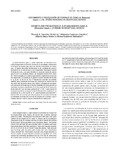
Please use this identifier to cite or link to this item:
http://ricaxcan.uaz.edu.mx/jspui/handle/20.500.11845/851| Title: | Growth and production of autumn-winter canola (Brassica napus L.) forage in Zacatecas, México |
| Other Titles: | Crecimiento y producción de forraje de canola (Brassica napus L.) de otoño-invierno en zacatecas, México |
| Authors: | Sánchez Gutiérrez, Ricardo Alonso Espinoza Canales, Alejandro Muro Reyes, Alberto Gutiérrez Bañuelos, Héctor |
| Issue Date: | 2018 |
| Publisher: | Sociedad Mexicana de Fitogenética |
| Abstract: | La canola (Brassica napus L.) puede representar una alternativa como cultivo forrajero para el ciclo otoño-invierno (O-I); sin embargo, se desconoce el momento de cosecha para lograr los máximos rendimientos de materia seca. El objetivo del estudio fue determinar en dos variedades de canola la acumulación de la materia seca y sus componentes morfológicos durante 10 fechas de corte, y así poder identificar el momento óptimo de cosecha para el ciclo O-I en Zacatecas, México. Las variedades Canorte 2010 y Hyola 401 fueron evaluadas en un diseño experimental completamente al azar con tres repeticiones. La cosecha de las plantas se realizó manualmente los días 9, 16, 23, 30, 42, 49, 56, 63, 70 y 77 después de la siembra. Las variables medidas fueron rendimiento de forraje seco, producción de materia seca de hoja verde, tallo, flor/botón, silicua y hoja muerta. La dinámica de crecimiento en la producción de forraje seco en las dos variedades de canola presentó un incremento constante y significativo (P ≤ 0.05) a partir del día 23 hasta el 63, donde Hyola 401 tuvo una mayor producción (P ≤ 0.05). El valor máximo de la tasa de crecimiento se presentó al día 63 después de la siembra, con un promedio de 69.2 y 59.3 kg MS ha-1 d-1, respectivamente, para Hyola 401 y Canorte 2010. Se concluye que la fecha óptima de corte para incrementar el rendimiento de forraje seco es el día 63 después de la siembra, y que la variedad Hyola 401 muestra mayores rendimientos de materia seca. |
| Description: | Canola (Brassica napus L.) might represent an alternative as a forage crop for Autumn-Winter cycle; however, the harvest time to achieve maximum yields of dry matter. The objective of this study was to determine in two canola varieties the accumulation of dry matter is unknown and its morphological components during 10 cut dates, and thus, be able to identify the optimum harvest time for the Autumn-Winter cycle in Zacatecas, Mexico. The Varieties Canorte 2010 and Hyola 401 were evaluated under a completely randomized experimental design with three replications. Plants were manually harvested at 9, 16, 23, 30, 42, 49, 56, 63, 70 and 77 days after planting. Traits measured were dry forage yield, dry matter yield of green leaf, stem, flower/button, siliqua, and dead leaf. The dynamics of growth in dry forage production in the two varieties of canola showed a constant and significant (P ≤ 0.05) increase and statistically significative from day 23 to day 63, where Hyola 401 showed higher production (P ≤ 0.05). The maximum value of growth rate was observed at day 63 after planting, with an average of 69.2 and 59.3 kg Ms ha-1 d-1, respectively for Hyola 401 and Canorte 2010. It is concluded that the optimal harvest time to increase dry forage yield is day 63 after planting, and that Hyola 401 variety shows higher yields of dry matter. |
| URI: | http://localhost/xmlui/handle/20.500.11845/851 https://doi.org/10.48779/r4fx-nw02 |
| ISSN: | 0187-7380 |
| Other Identifiers: | info:eu-repo/semantics/publishedVersion |
| Appears in Collections: | *Documentos Académicos*-- UA Veterinaría |
Files in This Item:
| File | Description | Size | Format | |
|---|---|---|---|---|
| 1.- 2018 Ricardo A Sanchez et al Rev Fitotec Mex 2018.pdf | 366,93 kB | Adobe PDF |  View/Open |
This item is licensed under a Creative Commons License
